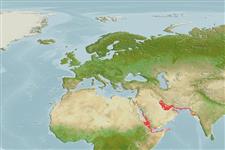>
Blenniiformes (Blennies) >
Blenniidae (Combtooth blennies) > Salariinae
Etymology: Alloblennius: Greek, allos = other + Greek, blennios = mucus (Ref. 45335).
Environment: milieu / climate zone / kisaran kedalaman / distribution range
Ekologi
laut dasar (demersal). Tropical
Western Indian Ocean: Gulf of Aqaba, the Red Sea, and Djibouti, Gulf of Tadjoura.
Size / Weight / umur
Kematangan: Lm ? range ? - ? cm
Max length : 2.6 cm SL jantan/; (Ref. 27664)
Oviparous. Eggs are demersal and adhesive (Ref. 205), and are attached to the substrate via a filamentous, adhesive pad or pedestal (Ref. 94114). Larvae are planktonic, often found in shallow, coastal waters (Ref. 94114).
Oviparous, distinct pairing (Ref. 205).
Springer, V.G., H. Bath and J.E. Randall, 1998. Remarks on the species of the Indian Ocean fish genus Alloblennius Smith-Vaniz & Springer 1971, (Blennidae). aqua, J. Ichthyol. Aquat. Biol. 3(1):19-24. (Ref. 27664)
Status IUCN Red List (Ref. 130435: Version 2025-1)
ancaman kepada manusia
Harmless
penggunaan manusia
Alat, peralatan
laporan khas
muat turun XML
Sumber internet
Estimates based on models
Preferred temperature (Acuan
123201): 24.7 - 29.4, mean 28.5 °C (based on 134 cells).
Phylogenetic diversity index (Acuan
82804): PD
50 = 0.5312 [Uniqueness, from 0.5 = low to 2.0 = high].
Bayesian length-weight: a=0.00832 (0.00448 - 0.01544), b=3.00 (2.84 - 3.16), in cm total length, based on LWR estimates for this species & (Sub)family-body (Ref.
93245).
Daya lenting (Acuan
120179): Tinggi, Waktu penggandaan populasi minimum kurang dari 15 bulan (Preliminary K or Fecundity.).
Fishing Vulnerability (Ref.
59153): Low vulnerability (10 of 100).
🛈
